
Actor Onoe Baikō, artist Kunisada, publisher Ibaya Kyūbei, c. 1820.


Actor Onoe Baikō, artist Kunisada, publisher Ibaya Kyūbei, c. 1820.



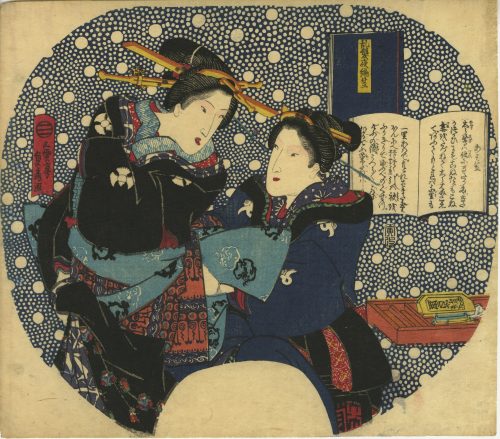
| Yukari no Edo-zakura | The tatami night robe of Iwao | Tangled Hair and the Evening Braided Hat |


Title: Suzume fukube [美人団扇絵] (Sparrow and gourds).
Series: Kacho awase [花鳥合] (Collection of flowers and birds).
Publisher: Aritaya Seiemon [有田屋 清右衛門] (Japanese, fl. c. 1830 – 1862); Seal: Marks 17-011 | 014d.Signed: Ichiyosai Kuniyoshi ga in a red cartouche and sealed with paulownia crest (kiri mon).
Size: Uchiwa-e (untrimmed fan print) 296 x 230 mm.
Double nanushi censor seals: Kinugasa & Watanabe, Kaei 2-3 (1849–50).
Ref.: Kuniyoshi Project.

 Reference images:
Reference images:






 A famous Yoshiwara courtesan named Manjiya Yatsuhashi [万字屋 八ツ橋] was killed by a provincial commoner Sano Jirōzaemon [佐野次郎左衛門] (on the second sheet of the pair):
A famous Yoshiwara courtesan named Manjiya Yatsuhashi [万字屋 八ツ橋] was killed by a provincial commoner Sano Jirōzaemon [佐野次郎左衛門] (on the second sheet of the pair):
 SVJP-0298.2019: Ichikawa Ebizō V as Sano Jirōzaemon. |
 SVJP-0297.2019: Iwai Kumesaburō III as Manjiya Yatsuhashi |
 One more example can be seen in the two upper images at Waseda University Cultural Resources Database, № 006-2707:
One more example can be seen in the two upper images at Waseda University Cultural Resources Database, № 006-2707:





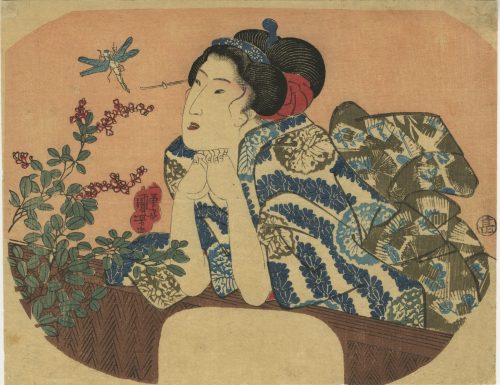
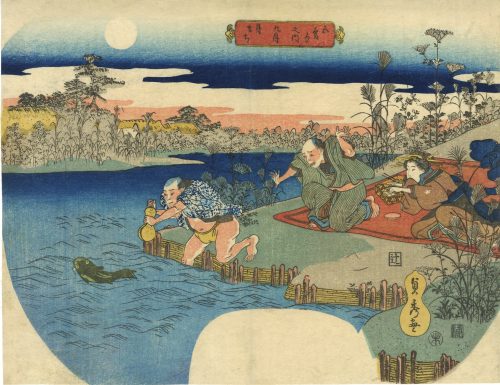


 Uncut fan print (uchiwa-e) depicting Onoe Kikugorō IV as Karukaya Dōshin parting from his son, Ishidomaru (played by Ichimura Uzaemon XIII), and Kawarasaki Gonjūrō I as Yamazakiya Yogoro in the kabuki play Karukaya Dōshin Tsukushi no Iezuto [苅萱桑門筑紫𨏍], written by Namiki Sōsuke [並木宗輔] (Japanese, 1695 – 1751) and performed at Ichimuraza [市村座] in 05/1856.
Media: Fan print [団扇絵] (Uchiwa-e); size: 235 x 305 mm.
Actors:
Onoe Kikugorō IV [四代目 尾上菊五郎] (Japanese, 1808 – 1860); other names: Onoe Baikō IV, Onoe Eizaburō III, Onoe Kikue, Nakamura Tatsuzō, Nakamura Kachō.
Onoe Kikugorō V [五代目尾上菊五郎] (Japanese, 1844 – 1903 other names: Onoe Baikō V, Ichimura Kakitsu IV, Ichimura Uzaemon XIII [十三代目市村羽左衛門], Ichimura Kurōemon.
Ichikawa Danjūrō IX [市川団十郎] (Japanese, 1838 – 1903); other names: Kawarasaki Sanshō, Kawarasaki Gonnosuke VII, Kawarasaki Gonjūrō I, Kawarasaki Chōjūrō III.
Plot: It was a popular belief at one time that jealous women had their hair transformed into writhing serpents and Kato Sayemon Shige-Uji, a daimyo of Tsukushi, a much-married man, suffered from the delusion that his wife was so affected. He fled to the mountains to escape her and led the life of a hermit under the name of Karukaya Doshin [苅萓道心]. One day, on Mount Kōya (高野山, Kōyasan) Karukaya meets a young man who was wandering in the mountains. Being questioned, the youth tells his name, Ishidomaru, and elicits the information that he is seeking his lost father. Karukaya then recognizes the boy as his own son, but firm in the resolve to remain lost to the world, he refrains from disclosing himself, and bids the youth return home.
Provenance: Paul F. Walter (American, 1935 – 2017).
Ref.:
Uncut fan print (uchiwa-e) depicting Onoe Kikugorō IV as Karukaya Dōshin parting from his son, Ishidomaru (played by Ichimura Uzaemon XIII), and Kawarasaki Gonjūrō I as Yamazakiya Yogoro in the kabuki play Karukaya Dōshin Tsukushi no Iezuto [苅萱桑門筑紫𨏍], written by Namiki Sōsuke [並木宗輔] (Japanese, 1695 – 1751) and performed at Ichimuraza [市村座] in 05/1856.
Media: Fan print [団扇絵] (Uchiwa-e); size: 235 x 305 mm.
Actors:
Onoe Kikugorō IV [四代目 尾上菊五郎] (Japanese, 1808 – 1860); other names: Onoe Baikō IV, Onoe Eizaburō III, Onoe Kikue, Nakamura Tatsuzō, Nakamura Kachō.
Onoe Kikugorō V [五代目尾上菊五郎] (Japanese, 1844 – 1903 other names: Onoe Baikō V, Ichimura Kakitsu IV, Ichimura Uzaemon XIII [十三代目市村羽左衛門], Ichimura Kurōemon.
Ichikawa Danjūrō IX [市川団十郎] (Japanese, 1838 – 1903); other names: Kawarasaki Sanshō, Kawarasaki Gonnosuke VII, Kawarasaki Gonjūrō I, Kawarasaki Chōjūrō III.
Plot: It was a popular belief at one time that jealous women had their hair transformed into writhing serpents and Kato Sayemon Shige-Uji, a daimyo of Tsukushi, a much-married man, suffered from the delusion that his wife was so affected. He fled to the mountains to escape her and led the life of a hermit under the name of Karukaya Doshin [苅萓道心]. One day, on Mount Kōya (高野山, Kōyasan) Karukaya meets a young man who was wandering in the mountains. Being questioned, the youth tells his name, Ishidomaru, and elicits the information that he is seeking his lost father. Karukaya then recognizes the boy as his own son, but firm in the resolve to remain lost to the world, he refrains from disclosing himself, and bids the youth return home.
Provenance: Paul F. Walter (American, 1935 – 2017).
Ref.:



Utagawa Kunimaru. Chūshingura, Act 11.
 Another fan print from the same series can be found at Kuniyoshi Project:
Another fan print from the same series can be found at Kuniyoshi Project:
 The same subject is portrayed by Kuniyoshi in the series Mirror of the True Loyalty of the Faithful Retainers [誠忠義臣鏡] (Seichû gishin kagami), publisher: Kagiya Hanjirô, c. 1851 (Kuniyoshi Project) – Yoshida Sadaemon Kanesada (葦田貞右衛門兼貞) raising his sword amid falling baskets and charcoal:
The same subject is portrayed by Kuniyoshi in the series Mirror of the True Loyalty of the Faithful Retainers [誠忠義臣鏡] (Seichû gishin kagami), publisher: Kagiya Hanjirô, c. 1851 (Kuniyoshi Project) – Yoshida Sadaemon Kanesada (葦田貞右衛門兼貞) raising his sword amid falling baskets and charcoal:



 Ref.: (1) [LIB-1197.2016] Arendie and Henk Herwig. Heroes of the kabuki stage: an introduction to kabuki with retellings of famous plays, illustrated by woodblock prints. — Amsterdam: Hotei Publishing, 2004; pp. 243-249.
Ref.: (1) [LIB-1197.2016] Arendie and Henk Herwig. Heroes of the kabuki stage: an introduction to kabuki with retellings of famous plays, illustrated by woodblock prints. — Amsterdam: Hotei Publishing, 2004; pp. 243-249.


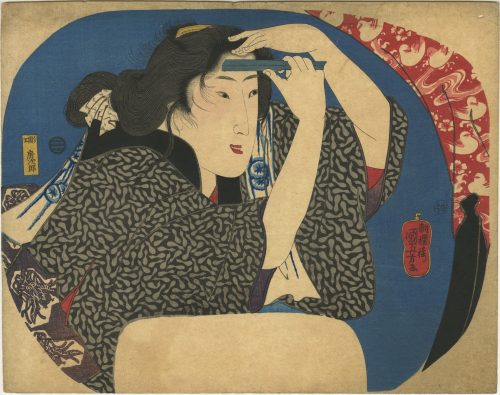




Signed: Ichiyosai Kuniyoshi ga in a red cartouche and sealed with paulownia (kiri mon).
Date seal and double nanushi censor seals: Fuku & Muramatsu, 1853 (Kaei 6, 2nd month).
Size: Uchiwa-e (untrimmed fan print) 296 x 230 mm.
 SVJP-0303.2019 |
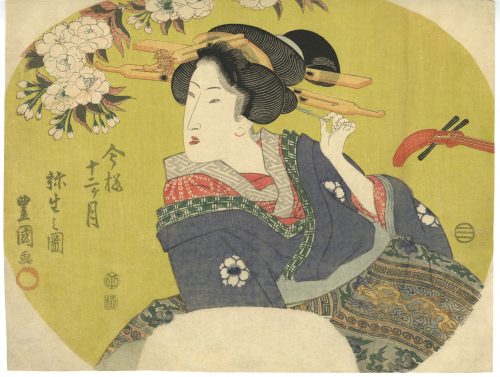
 |
 |
|---|

 |
 |
|---|



Signed: Toyohiro ga [豐廣画]
Catalogue raisonné: Jacob Pins, The Japanese Pillar Print, № 923, p. 326.
 As noted by Horst Graebner, the gentleman also resembles the character on another Kunisada's actor print, published in 1852 (Waseda University Cultural Resources Database № 114-0232):
As noted by Horst Graebner, the gentleman also resembles the character on another Kunisada's actor print, published in 1852 (Waseda University Cultural Resources Database № 114-0232):


Signed: Toyokuni ga [豊国 画] in a red toshidama cartouche.
Publisher: Kojimaya Jūbei (c. 1797-1869), seal: Hanmoto, Jū [板元, 十] (Marks 19-043 | 264c).
Double nanushi censor seals: Mera & Watanabe – Kaei 4 (1851).
Uncut fan print (uchiwa-e), 298 x 228 mm depicting a young woman adjusting her hairpin and holding a portable lantern (andon) on a marine background with the full moon, nearby boats and distant cormorant fishers.
 |
 |
|---|

